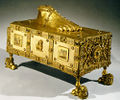Category:Relics of Andrew (subject)
According to Christian traditions, Relics of Andrew are (or were) preserved in several locations, notably, the Church of Saint Andrew in Patras [Greece], the Cathedral of St. Andrews and the Cathedral of Edinburgh in Scotland, the Church of St. Peter in Rome and the Cathedral of Amalfi [Italy].
Overview
Christian traditions narrates that the Apostle Andrew died as a martyr by crucifixion in Patras [Greece] and that his remains were translated to Constantinople by order of the Roman emperor Constantius II around 357 and deposited in the Church of the Holy Apostles.
The Relics of St. Andrew at Patras, Greece
Patras in Greece was the place where according to Christian tradition Andrew was executed and the place were all his relics were originally preserved. In the 4th cent. the relics were moved to Constantinople, from where they got dispersed with the sack of the city in 1204.
In September 1964, Pope Paul VI, as a gesture of goodwill toward the Greek Orthodox Church, ordered that some relics of Andrew that were in the Vatican be sent back to Patras [Greece], where are currently preserved in the Church of Saint Andrew.
The cross of. St. Andrew was taken during the Crusades by the Duke of Burgandy. Parts of the cross were kept since Middle Ages in the church of St. Victor in Marseilles. They were returned to Patras on 19 January 1980. The cross of the apostle was presented to the Bishop of Patras Nicodemus by the Roman Catholic delegation led by cardinal Roger Etchegaray.
The Relics of St. Andrew in Scotland (St. Andrews and Edinburgh)
It seems likely that Andrew's remains were brought to St. Andrews, Scotland around 733 by Acca, the Bishop of Hexham (now Newcastle), who was a renowned collector of relics.
By the 12th century, however, the legend narrated that in the 4th century a Greek Monk called St. Rule (or St. Regulus) was warned in a dream that Andrew's remains were about to be moved from Patras to Constantinople and was directed by an angel to take those of the remains which he could to the "ends of the earth". This was how the city of St. Andrews was born on the East Coast of Scotland.
In 1158 the Cathedral of St. Andrews was founded to house the relics and the thousands of pilgrims visiting the site. The relics traditionally consisted of three fingers of the saint’s right hand, a part of one of his arms, one kneecap, and one of his teeth.
These remains of Andrew went lost during the Scottish Reformation in the 16th century. Today a plaque amongst the ruins of the destroyed Cathedral is all is left to mark the place where the relics were once kept.
In 1879 the Archbishop of Amalfi (see below) sent a small piece of the Apostle's shoulder blade to the re-established Roman Catholic community in Scotland, and in 1969 further relics of Andrew were given by Pope Paul VI to Scottish Card. Gordon Gray. These are now displayed in a reliquary in St. Mary's Roman Catholic Cathedral in Edinburgh.
The Tomb of St. Andrew at Amalfi, Campania, Italy==
In 1206, following the sack of Constantinople of 1204, Cardinal Peter Capuano presented to his native town of Amalfi [Italy] the remains of the Apostle Andrew. The tomb of Andrew was completed in 1208 and is still located in the crypt of the Cathedral of Amalfi.
A small piece of the Apostle's shoulder blade was sent in 1897 from Amalfi as a gift to the re-established Roman Catholic community in Scotland. In 2008 the Vatican gave to Amalfi a small portion of the skull of the Apostle.
The Relics of St. Andrews in the Vatican ==
In 1461 the Byzantine despot Thomas Palaeologus presented portion of the head and other relics of Andrew to Pope Pius II. Some of these relics were given by the Vatican to Patras (1964), Edinburgh (1969), and Amalfi (2008).
The Sandals of St. Andrew at Trier, Germany
A 10th century golden reliquary containing a sole of one of the sandals of Andrew is preserved in the Treasury of the Cathedral of Trier, Germany.
Other Relics
Relics of the Apostle Andrew are also kept in the Chapel of the Patriarchal Residence in Bucharest [Romania], at the Church of St Andrew and St Albert in Warsaw [Poland] (since 2003), and in numerous smaller reliquaries throughout the world.
External links
- [ Wikipedia]
This category currently contains no pages or media.









